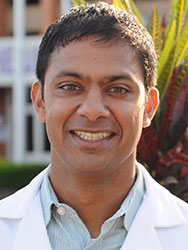Building neurology research capacity in Zambia: Q and A with Dr. Omar Siddiqi
January / February 2019 | Volume 18, Number 1

Omar Siddiqi, M.D., M.P.H.
Dr. Omar Siddiqi first visited Zambia in 2005 when he was a neurology resident at Beth Israel Deaconess Medical Center to explore the possibilities of doing global health neurology research there. Named a Fogarty International Clinical Research Fellow in 2010, he moved to the southern African country and has been there ever since. In 2018, he helped launch Zambia’s first neurology research training program. Siddiqi is an assistant professor of neurology at Harvard Medical School, the Director of the
Global Neurology Program at Beth Israel Deaconess Medical Center, and a lecturer at the University of Zambia.
What impact has Fogarty had on your career?
Fogarty was the spark that made everything else happen. When I first went to Zambia in 2005, there were few, if any, mechanisms outside of Fogarty that allowed me to combine neurology research and global health. I was able to return to Zambia in 2010 as a Fogarty fellow with an early career scientist’s award, and prove there are important research questions relevant to low- and middle-income countries (LMICs) and the U.S.
What research question did you investigate?
I studied the causes of infections in the brain in the HIV population, mainly meningitis and encephalitis. At the time there was just one neurologist, from the former Soviet Union, working in Zambia, and scant information about my research topic, despite the country’s huge burden of tuberculosis meningitis in the HIV population. We got very good data and published a paper.
What are the key outcomes of your research?
We’ve classified the full spectrum of neurological diseases in the HIV population and found that there’s a huge neurological disease burden outside of HIV in LMICs. This has helped to spur the neurology training program we launched in Zambia in October 2018, which will put more boots on the ground and allow us to see the disease processes in various parts of the country. In the first year of the program, there were three adult and two pediatric neurologists in training, all of them from Zambia. This training program will enrich the research environment in Zambia and allow us to look at neurological diseases in more detail, build capacity, and answer research questions that help LMICs and countries like the U.S.

Photo courtesy of Dr. Omar Siddiqi
Dr. Omar Siddiqi (right), who helped launch Zambia’s first neurology
research training program, discusses a patient’s diagnosis with her
family and a trainee.
How does research in Zambia benefit the U.S.?
A lot of the diagnostic technologies for TB meningitis have been rolled out in LMICs, where the disease is highly prevalent. TB meningitis occurs in the U.S., but not with the critical mass of patients that you need to answer important diagnosis and management questions, so the U.S. looks to data from countries like Zambia to help guide how to treat its TB meningitis patients.
How has mentorship influenced your career?
Mentorship has been critical. When I started out on this career path, I didn’t know anything about funding opportunities, about how to balance a career in the U.S. with something overseas. But my mentors - Dr. Gretchen Birbeck, who has been doing neurology research in Zambia since 2001, and Dr. Igor Koralnik, then the director of the HIV/Neurology Center at my home institution, Beth Israel Deaconess Medical Center - took me under their wings and gave me sound advice: Start by finding a research question you’re interested in, that’s relevant to the setting, and that you can carry through to completion. I started writing grants with Igor and eventually got support from Fogarty, along with several others.
What are your goals for neurology in Zambia?
In 10-20 years, I’d like to have a neuroscience institute with advanced diagnostics and research facilities, where Zambians would receive training and local neuroscientists would conduct research. People from neighboring countries that lack neurology training programs, such as Botswana, Zimbabwe and Mozambique, would come to the institute for training. South Africa does this quite well but Africa’s huge, so you need more than one country to provide training for others.
How has neurology advanced in LMICs?
When I first got to Zambia, they had no neuroimaging, they were doing rudimentary testing on spinal fluid, there were no advanced neurological tests, no training program. Now, we have a training program, a CT scanner, an MRI scanner, a fully functioning neurophysiology lab, and a neurology clinic where we see up to 60 patients a day. We’ve moved mountains. It’s enormous progress and it’s been catalyzed by NIH support.
More Information
To view Adobe PDF files,
download current, free accessible plug-ins from Adobe's website.